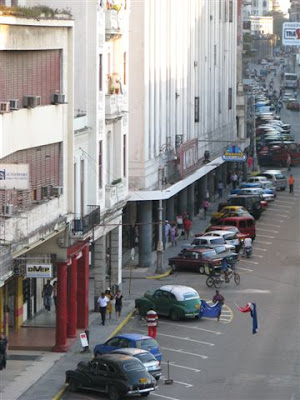Viva La Revolucion... (pt 1 of 3)
We'd both longed to get to Cuba, and after moving to the US it was always going to be our first port of call - before Fidel kicks the bucket and Raoul starts changing everything. It just so happened that 2009 is the 50th anniversary of the Revolution, so we figured we should be there over Christmas and new years to witness it...

Havana is a one of those cities that's more legend than fact. Since the revolution and the subsequent embargo by the US, the city has unfortunately in decline. It's probably one of the few places on the planet where you find vintage American cars running off Russian Lada engines, ration shops juxtaposed against once gleaming colonial palaces all dowsed in a liberal coating of revolutionary sloganeering and graffiti
Once the stomping ground for pirates, a heavily fortified slave port for the Spanish and even a lucrative gambling capital for the North American Mafia during prohibition, Havana seems to have survived everything that has been thrown at it...

 The fort at La Cabaña has overlooked and protected the city for over 100yrs - so much so, that Fidel and Che set up shop here immediately after the revolution. There's an awesome display of che's old office and a whole bunch of his stuff from the early days running the new country
The fort at La Cabaña has overlooked and protected the city for over 100yrs - so much so, that Fidel and Che set up shop here immediately after the revolution. There's an awesome display of che's old office and a whole bunch of his stuff from the early days running the new country








One thing that strikes most people about Cuba is that it's still a government run Communist state, and as such doesn't have any advertising or commercial branding anywhere (even on the limited number of shops...) So, while there's no Coke or Pepsi billboards staring down at you wherever you go like the rest of the planet, there are plenty of political slogans and patriotic images all about the place to remind cubanos about their responsibilities as a cuban...
 "Fatherland or Death - We will win" has been a slogan since before the revolution when an "oath" was pledged to rid the country of the spanish (at the time). Since then it has evolved to mean more - that every cuban is required to fight for the greater good and the freedom on the country... Here Fidel (in his younger days) is rousing his people...
"Fatherland or Death - We will win" has been a slogan since before the revolution when an "oath" was pledged to rid the country of the spanish (at the time). Since then it has evolved to mean more - that every cuban is required to fight for the greater good and the freedom on the country... Here Fidel (in his younger days) is rousing his people... No one man conveys that spirit of vigilance is fighting against oppression than "El Che" who is coveted almost like a god in these parts. His image (and sometimes a simple "viva el che!" or "viva la revolucion!") can be seen in houses, on billboards, and the side of buildings, in every corner of cuba...
No one man conveys that spirit of vigilance is fighting against oppression than "El Che" who is coveted almost like a god in these parts. His image (and sometimes a simple "viva el che!" or "viva la revolucion!") can be seen in houses, on billboards, and the side of buildings, in every corner of cuba...


 Another group that cubanos are constantly reminded of via billboard is the Miami 5 - five men who were sentenced in 2001 to prison terms of between 15 and 25 years for allegedly acting as Cuban agents within the exile community in Miami. The men and their supporters have consistently protested that they had come to the US to infiltrate and disrupt right-wing exile groups perpetrating acts of terrorism within Cuba and have therefore been jailed unjustly. As for the local propaganda, it's used to help bolster anti-American sentiment (such as the common phrase "Yankee imperialist..."
Another group that cubanos are constantly reminded of via billboard is the Miami 5 - five men who were sentenced in 2001 to prison terms of between 15 and 25 years for allegedly acting as Cuban agents within the exile community in Miami. The men and their supporters have consistently protested that they had come to the US to infiltrate and disrupt right-wing exile groups perpetrating acts of terrorism within Cuba and have therefore been jailed unjustly. As for the local propaganda, it's used to help bolster anti-American sentiment (such as the common phrase "Yankee imperialist..." 
































